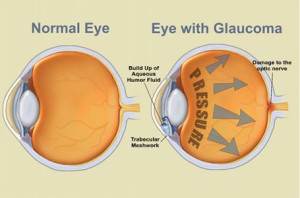What is Glaucoma?
 Glaucoma is an eye disease characterized by increased pressure inside the eye caused by a malfunction in the eye’s fluid drainage system. This increase in eye pressure (or intraocular pressure) reduces blood flow to the optic nerve and causes retinal nerves to die, resulting in a progressive decrease in your vision, starting with your side vision.
Glaucoma is an eye disease characterized by increased pressure inside the eye caused by a malfunction in the eye’s fluid drainage system. This increase in eye pressure (or intraocular pressure) reduces blood flow to the optic nerve and causes retinal nerves to die, resulting in a progressive decrease in your vision, starting with your side vision.
Certain people are at a greater risk for developing Glaucoma than others. These are:
- People over the age of 60
- African Americans over the age of 40
- People with a family history of Glaucoma
- Diabetics
- People on long-term steroid treatments
- People with high blood pressure
How do I know if I have Glaucoma?
In the early stages of glaucoma, patients will have NO symptoms at all. That is why it is very important to have regular eye exams so that your Optometrist can perform screening tests to see if you are at risk for developing glaucoma. Your optometrist will do one or more of the following tests to assess whether or not you are at risk:
- Measurement of intraocular pressure
- Dilated examination of the Optic Nerve
- Pachymetry (measures thickness of the cornea)
- Gonioscopy (to assess the drainage system of the eye)
- Visual Field testing (to test your side vision)
- Retinal imaging (photographs, OCT scans)
How is Glaucoma treated?
If your Optometrist determines that you have Glaucoma, you will be prescribed eye drops to help lower your intraocular pressure. Since there is no cure for Glaucoma, these drops will have to be taken regularly for the long-term to keep your pressure down. Your Optometrist will want to see you every 3-6 months to make sure your Glaucoma is not progressing.
Sometimes eye drops are not enough to keep the intraocular pressure in check. If this is the case, your Optometrist will refer you to a specialist for a laser or surgical procedure to help lower your intraocular pressure.






Follow Us!